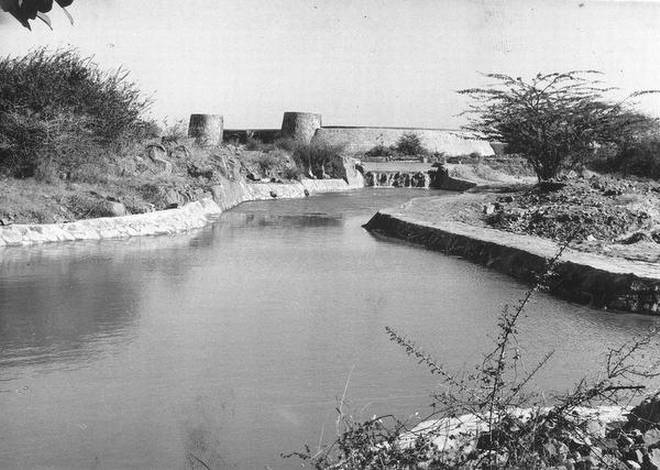NEW DELHI :

The news of a maulvi living in an alcove of the Ridge area makes one reflect on the legacy of Feroz Shah Tughlaq who respected men of divinity
Police accosting a maulvi in a forest bordering the Bodyguard Lines of the President’s Estate recently should cause little wonder. Ghazi Norool Hassan, say reports, was found living in an alcove of the Ridge area along with his son, claiming to be the caretaker of a mazar. This shrine is supposed to be very old and in keeping with the legacy of the reign of Feroz Shah Tughlaq. A large part of Delhi was forest area in the 14th Century and this helped the Emperor to indulge in his favourite past-time of hunting. Right from Mehrauli to North Delhi there is evidence of the Sultan’s hunting lodges where he sometimes rested at night too.
While in North Delhi he built an observatory, besides a hunting lodge, a Pir of his time also set up abode in the area and, after drawing a lot of devotees, disappeared one fine day, leaving his admirers shocked. The place has come to be known as Pir Ghaib. On the Ridge near Karol Bagh is the ruined gate of Bhuli Bhatiyari-ka-Mahal. Though Sir Syed Ahmad Khan thought it was a distortion of the name of a nobleman, Bhu Ali Bhatti, there are not many takers for this assertion.
If oral history is to be believed, Bhuli Bhatiyari was the comely daughter of a dhaba owner (Bhaitiyara) with whom the Sultan fell in love while passing that way. There is incidentally a Bhuri Bhatiyari-ki-Masjid (dedicated to a fair innkeeper) opposite the Khooni Darwaza. Another story says Feroz Shah actually fell in love with a gypsy girl for whom he built a palace as she had stolen his heart after offering him a drink of water on a hot summer day while the Sultan was out hunting.
Historian Ishwari Prasad says that Feroz Shah was a pious man, despite being an orthodox Sunni who ill-treated the Shias and non-Muslims. But at the same time he was generous and not fond of shedding blood, like his cousin and mentor Mohammed Bin Tughlaq, whom he had succeeded. Feroz was a great devotee of dervishes, many of whom flourished in his empire. One of them probably was the Pir Sahib of the place where the maulvi was found living secretly for 40 years. The forest area of which the shrine is a part, had many other dargahs which were demolished when New Delhi was built. Raisina Hill was also covered with a forest where wolves, leopards and hyenas were found. So a Forest Ranger’s bungalow was set up there. In later times, this bungalow became part of the Sacred Heart Cathedral and now after renovation, is known as Maria Bhawan.
Some old mosques still exist in nearby areas which may be dating back to Tughlaq times, for that matter the place where now stands Gurdwara Rakabganj was also a jungle once in which during Aurangzeb’s time lived a contractor, Lakhi Singh of the Mughal court. When Guru Tegh Bahadur was beheaded on the orders of Aurangzeb, there was a violent storm, taking advantage of which Lakhi Singh and his eight sons (who had come on horses and bullocks) took the body away, while the Guru’s head was taken away by a man named Jatha. Lakhi Singh drove all the way from Chandni Chowk to the forest where he lived and putting the body in his house set it on fire to avoid suspicion. Later Gurdwara Rakabganj came up there.
But to come back to Feroz Shah, the number of mosques and dargahs that were set up in his reign rivalled the inns, gardens and hospitals. He is said to have laid 1,200 gardens around Delhi and nearby areas in each of which a Sufi found refuge. The Sultan lived up to the age of 90, the longest living ruler of Delhi after Aurangzeb. He was so generous at heart that even while laying siege to a city he would often turn back on hearing the cries of women in distress and suffering from the pangs of hunger, along with their children. Even while on shikar, Feroz Shah would pay obeisance to saints who had set up abode in his empire. Many of them were helped by him to set up khankahs or hospices, and when they died the Sultan was always ready to build a mazar for them.
Once while visiting a dervish he was puzzled on seeing a goat and a tendua (panther) lying in the courtyard of the jungle abode. Seeing his amazement at the sight the dervish told him that in the royal darbar this may not be possible but in his khankah the goat and the panther could lie side by side, forgetting their enmity. When the British built what is now President’s Estate, they reclaimed a lot of forest land in which wild animals roamed. But still a lot of the area acquired by Lutyens and Baker was left as forest land. The mazar of which Noorol Hassan claims to be caretaker is only one among many hidden away from the public eye. Don’t be surprised if in course of time the mazar becomes a regular shrine with an annual Urs. But for this the history of the mazar and of the saint buried there would first have to be determined. Until then Ghazi Noorol Hassan can continue to be caretaker of the legacy bequeathed to him by Fakhruddin Ali Ahmed. The late President himself preferred to be buried outside the New Delhi Jama Masjid, opposite Parliament House, where once the heart-broken poet Hasrat Mohani of “Chupke, chupke aansoon bahana” fame had made his bachelor’s quarters.
source: http://www.thehindu.com / The Hindu / Home> Society> History & Culture / December 25th, 2016








